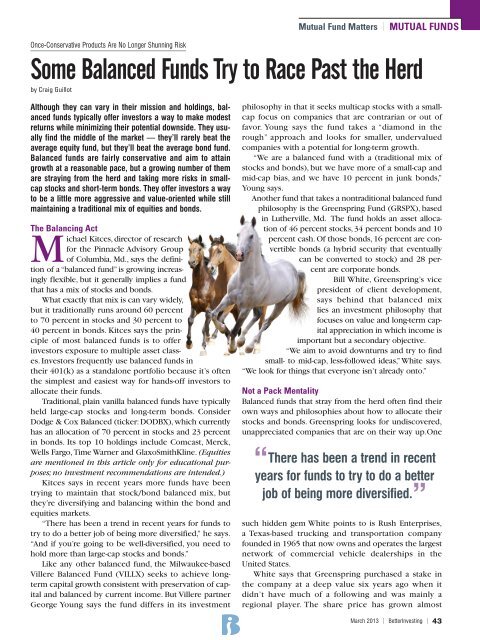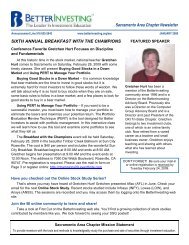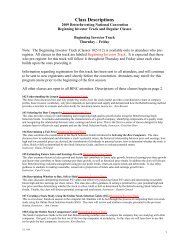STOCK TO STUDY: T. Rowe Price Group, Inc ... - BetterInvesting
STOCK TO STUDY: T. Rowe Price Group, Inc ... - BetterInvesting
STOCK TO STUDY: T. Rowe Price Group, Inc ... - BetterInvesting
Create successful ePaper yourself
Turn your PDF publications into a flip-book with our unique Google optimized e-Paper software.
Although they can vary in their mission and holdings, balanced<br />
funds typically offer investors a way to make modest<br />
returns while minimizing their potential downside. They usually<br />
find the middle of the market — they’ll rarely beat the<br />
average equity fund, but they’ll beat the average bond fund.<br />
Balanced funds are fairly conservative and aim to attain<br />
growth at a reasonable pace, but a growing number of them<br />
are straying from the herd and taking more risks in smallcap<br />
stocks and short-term bonds. They offer investors a way<br />
to be a little more aggressive and value-oriented while still<br />
maintaining a traditional mix of equities and bonds.<br />
The Balancing Act<br />
Michael Kitces, director of research<br />
for the Pinnacle Advisory <strong>Group</strong><br />
of Columbia, Md., says the definition<br />
of a “balanced fund” is growing increasingly<br />
flexible, but it generally implies a fund<br />
that has a mix of stocks and bonds.<br />
What exactly that mix is can vary widely,<br />
but it traditionally runs around 60 percent<br />
to 70 percent in stocks and 30 percent to<br />
40 percent in bonds. Kitces says the principle<br />
of most balanced funds is to offer<br />
investors exposure to multiple asset classes.<br />
Investors frequently use balanced funds in<br />
their 401(k) as a standalone portfolio because it’s often<br />
the simplest and easiest way for hands-off investors to<br />
allocate their funds.<br />
Traditional, plain vanilla balanced funds have typically<br />
held large-cap stocks and long-term bonds. Consider<br />
Dodge & Cox Balanced (ticker: DODBX), which currently<br />
has an allocation of 70 percent in stocks and 23 percent<br />
in bonds. Its top 10 holdings include Comcast, Merck,<br />
Wells Fargo, Time Warner and GlaxoSmithKline. (Equities<br />
are mentioned in this article only for educational purposes;<br />
no investment recommendations are intended.)<br />
Kitces says in recent years more funds have been<br />
trying to maintain that stock/bond balanced mix, but<br />
they’re diversifying and balancing within the bond and<br />
equities markets.<br />
“There has been a trend in recent years for funds to<br />
try to do a better job of being more diversified,” he says.<br />
“And if you’re going to be well-diversified, you need to<br />
hold more than large-cap stocks and bonds.”<br />
Like any other balanced fund, the Milwaukee-based<br />
Villere Balanced Fund (VILLX) seeks to achieve longterm<br />
capital growth consistent with preservation of capital<br />
and balanced by current income. But Villere partner<br />
George Young says the fund differs in its investment<br />
Mutual Fund Matters | MUTUAL FUNDS<br />
Once-Conservative Products Are No Longer Shunning Risk<br />
Some Balanced Funds Try to Race Past the Herd<br />
by Craig Guillot<br />
philosophy in that it seeks multicap stocks with a smallcap<br />
focus on com panies that are contrarian or out of<br />
favor. Young says the fund takes a “diamond in the<br />
rough” approach and looks for smaller, undervalued<br />
companies with a potential for long-term growth.<br />
“We are a balanced fund with a (traditional mix of<br />
stocks and bonds), but we have more of a small-cap and<br />
mid-cap bias, and we have 10 percent in junk bonds,”<br />
Young says.<br />
Another fund that takes a nontraditional balanced fund<br />
philosophy is the Greenspring Fund (GRSPX), based<br />
in Lutherville, Md. The fund holds an asset allocation<br />
of 46 percent stocks, 34 percent bonds and 10<br />
percent cash. Of those bonds, 16 percent are con -<br />
vertible bonds (a hybrid security that eventually<br />
can be converted to stock) and 28 percent<br />
are corporate bonds.<br />
Bill White, Greenspring’s vice<br />
president of client development,<br />
says behind that balanced mix<br />
lies an investment philosophy that<br />
fo cuses on value and long-term capital<br />
appreciation in which income is<br />
important but a secondary objective.<br />
“We aim to avoid downturns and try to find<br />
small- to mid-cap, less-followed ideas,” White says.<br />
“We look for things that everyone isn’t already onto.”<br />
Not a Pack Mentality<br />
Balanced funds that stray from the herd often find their<br />
own ways and philosophies about how to allocate their<br />
stocks and bonds. Greenspring looks for undiscovered,<br />
unappreciated companies that are on their way up.One<br />
“<br />
There has been a trend in recent<br />
years for funds to try to do a better<br />
job of being more diversified. ”<br />
such hidden gem White points to is Rush Enterprises,<br />
a Texas-based trucking and transportation company<br />
founded in 1965 that now owns and operates the largest<br />
network of commercial vehicle dealerships in the<br />
United States.<br />
White says that Greenspring purchased a stake in<br />
the com pany at a deep value six years ago when it<br />
didn’t have much of a following and was mainly a<br />
regional player. The share price has grown almost<br />
March 2013 | <strong>BetterInvesting</strong> | 43





